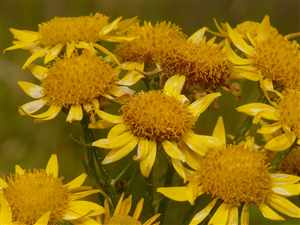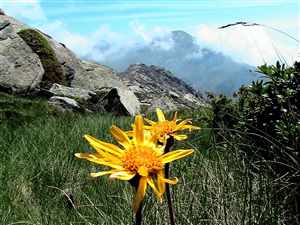Arnica (Arnica montana)
Main Facts about Arnica

Arnica is an aromatic hardy perennial that forms a basal rosette of downy leaves. From late spring to late summer, it produces erect, branching stems up to 2 feet (60 cm) high. Each stem ends in a yellow-orange daisy-like flower. Arnica blooms in midsummer to late summer. Its name may be derived from “arnakis”, the ancient Greek word for “lambskin”, in reference to the plant’s soft leaves.
Parts used – flowers.
It is native to the mountains of Europe and Siberia. Arnica grows in meadows up to nearly 9,800 feet (3,000 m). Arnica is becoming rare, due to over-collection and intensive agriculture, and its wild collection is being reduced.
Arnica’s ability to soothe muscle aches, sprains, and bruises has been known for centuries, both in Europe and North America. While European herbalists used their native mountain Arnica to make healing remedies, Native Americans used native North American species, such as broad leaf Arnica (Arnica latifolia) and heartleaf Arnica (Arnica cordifolia). There are about 30 species of Arnica, and all of them are perennials that spread by rhizomes.
Using Arnica
Arnica has a long history of use as a topical treatment for bruises and for helping them to heal quickly. Users often report that their bruises change color more quickly and consider this an indication that the healing process is enhanced. It is also traditionally indicated for the treatment of swollen or sprained tissue.
A popular remedy around the world, Arnica has anti-inflammatory and antiseptic properties, the former credited to the compound helenalin and the latter due in part to compounds related to thymol. It is used externally to treat sprains, bruises, swelling, and joint pain, and it is a key ingredient in many first-aid creams and gels.
To make your own remedy for bruises and sore muscles, gently heat 1 oz. of Arnica flowers in 1 oz. of oil for several hours. Strain and let the infused oil cool before using it.
Arnica can be found in a highly diluted form in mouthwash, although it is strictly for rinsing and should not be swallowed.
Apply Arnica cream, ointment or infused oil to the affected area 3 times per day. Choose a product that contains 10 to 20 % Arnica tincture or oil.
Caution!
Do not take Arnica internally, except in homeopathic preparations under the guidance of a health-care professional.
Do not apply it to broken skin or near the eyes or mouth.
Do not use topical applications of Arnica for more than 10 days at a time.
May cause reactions, such as dermatitis, or itching and burning sensations if you are allergic to the Asteraceae family (daisie, chrysanthemum and Echinacea) or if you are allergic to the Lauraceae family (sassafras, avocado, camphor laurel).
How to grow Arnica

Plant root divisions in spring, or sow seeds in fall. In milder winter areas, stratify the seeds by mixing them with a little damp vermiculite or sterile sand. Seal it in a plastic bag, and place it in the crisper tray of the refrigerator for about 12 weeks before sowing.
Arnica is a slow grower and dislikes competition from weeds such as white clover. Mulch well and weed regularly.
Harvest the flowers when fully open and dry them.
| Anise |
Ashwagandha
|